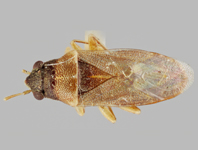Abstract
The species of genus Sadoletus are revised based on re-examination of the type material. A total of eighteen species are recognized in this genus, including five new species: Sadoletus abathonotus sp. nov., Sadoletus alphus sp. nov., Sadoletus biprotuberans sp. nov., and Sadoletus planus sp. nov. from China, and Sadoletus variabilis sp. nov. as the first representative of the genus from Australia, described in the present contribution. The following new subjective synonymy is proposed: Sadoletus validus Distant, 1903 = Sadoletus subpellucidus Ban, 2018 syn. nov. Sadoletus valdezi as treated in Ban & Ishikawa (2013) is proved to be a misidentification, now correctly described as Sadoletus planus sp. nov.. Three species, Sadoletus validus Distant, 1903, Sadoletus voluptarius Bergroth, 1918, Sadoletus melasmus Ban, 2018 are newly recorded from China. A key to all the known species of Sadoletus is provided. The lectotypes and paralectotypes are designated for S. validus Distant, 1903, S. pallescens Distant, 1909, S. valdezi Bergroth, 1918, S. voluptarius Bergroth, 1918, S. montanellus Bergroth, 1918 and S. montivagus Bergroth, 1918. Based on external and genitalia morphology, two “species groups” have been recognized amongst the species described in this genus until now. The main group, including 14 of the 18 known species, is confirmed as the typical Sadoletus (with type-species S. validus), for which a redefinition is provided. However the generic placement of the remaining four species is unclear at present, hence are tentatively retained under the present genus Sadoletus, pending further investigation involving other related heterogastrid genera, and using both morphological and molecular data.
References
Ashlock, P.D. (1957) An investigation of the taxonomic value of the phallus in the Lygaeidae (Hemiptera-Heteroptera). Annals of the Entomological Society of America, 50, 407–426.
https://doi.org/10.1093/aesa/50.4.407
Ban, T. (2018) The lygaeoid bug family Heterogastridae (Hemiptera: Heteroptera: Lygaeoidea) from Laos and Thailand, with descriptions of three new species. Zootaxa, 4446 (1), 051–067.
https://doi.org/10.11646/zootaxa.4446.1.4
Ban, T. & Ishikawa, T. (2013) The lygaeoid bug genus Sadoletus Distant (Hemiptera: Heteroptera: Heterogastridae) from Japan. Zootaxa, 3609 (2), 195–203.
https://doi.org/10.11646/zootaxa.3609.2.5
Bergroth, E. (1918) Studies in Philippine Heteroptera, I. Philippine Journal of Science, D, 13 (2 & 3), 43–73 & 75–126.
Dellapé, P.M. & Henry, T.J. (2019) Lygaeoidea Species File. Version 5.0/5.0. Available from: http://Lygaeoidea.SpeciesFile.org/ (accessed 26 February 2019)
Distant, W.L. (1903) The Fauna of British India, including Ceylon and Burma. Rhynchota.—Vol. II. (Heteroptera). Part 1. Taylor and Francis, London, 242 pp.
Distant, W.L. (1908) Rhynchota Malayana. Part I. Records of the Indian Museum, 2, 127–151, pls. VII–VIII.
Distant, W.L. (1909) Rhynchotal notes. XLVII. Annals and Magazine of Natural History, Series 8, 3 (16), 317–345.
https://doi.org/10.1080/00222930908692586
Gao, C.Q., Kondorosy, E. & Bu, W.J. (2013) A review of the genus Arocatus from Palaearctic and Oriental Regions (Hemiptera: Heteroptera: Lygaeidae). The Raffles Bulletin of Zoology, 61 (2), 687–704.
Gao, C.Q. & Rédei, D. (2017) The identity of Equatobursa, with proposal of new genus and species level synonymies (Hemiptera: Heteroptera: Heterogastridae). Zootaxa, 4237 (2), 300–306.
https://doi.org/10.11646/zootaxa.4237.2.4
Ishikawa, T. & Tomokuni, M. (2012) Family Heterogastridae Stål, 1872. In: Ishikawa, T., Takai, M. & Yasunaga, T. (Eds.), A field guide to Japanese bugs – Terrestrial heteropterans. Vol. 3. Zenkoku Noson Kyoiku Kyokai Publishing Co., Tokyo, pp. 315–317, pl. 67. [in Japanese]
Kondorosy, E. & Kóbor, P. (2016) A revision of Hyginellus (Hemiptera: Heteroptera: Heterogastridae). Entomologica Americana, 122 (1–2), 72–81.
Péricart, J. (2001) Family Lygaeidae Schilling, 1829—Seed-bugs. In: Aukema, B. & Rieger, Ch. (Eds.), Catalogue of the Heteroptera of the Palaearctic Region. Vol. 4. Pentatomomorpha I. Netherlands Entomological Society, Amsterdam, pp. 35–220.
Schaefer, C.W. (1981) The morphology and relationships of the Stenocephalidae and Hyocephalidae (Hemiptera: Heteroptera: Coreoidea). Annals of the Entomological Society of America, 74 (1), 83–95.
https://doi.org/10.1093/aesa/74.1.83
Scudder, G.G.E. (1962) New Heterogastrinae (Hemiptera) with a key to the genera of the world. Opuscula Entomologica, 27, 117–127.
Slater, J.A. (1964) A catalogue of the Lygaeidae of the world. Vols. I–II. University of Connecticut, Storrs, XVIII + 1668 pp. [I: I–XVIII, 1–778; II: 779–1668]
Zheng, L.Y. & Zou, H.G. (1981) Lygaeidae. In: Hsiao, T.Y., Ren, S.Z., Zheng, L.Y., Jing, X.L., Zou, H.G. & Liu, S.L. (Eds.), A handbook for the determination of the Chinese Hemiptera-Heteroptera. Vol. 2. Science Press, Beijing, pp. 1–215, plates 1–26. [in Chinese, English summary]
Zou, H.G. (1985) A new genus and species of Heterogastrinae from China (Hemiptera: Lygaeidae). Acta Scientiarum Naturalium Universitatis Nankaiensis, 1985 (2), 93–96. [in Chinese, English summary]

